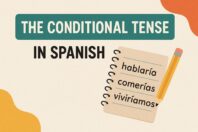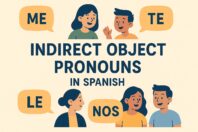Stem Changing Verbs in Spanish: Explained For Beginners

Get our free email course, Shortcut to Conversational.
Have conversations faster, understand people when they speak fast, and other tested tips to learn faster.
More infoAs the name suggests, stem changing verbs in Spanish are verbs that when conjugated in the simple present tense, undergo a vowel change in the last syllable of the stem.
Let’s break this down.
What Is The Stem of a Spanish Verb?
The stem is the part of the verb form that contains the underlying meaning of the verb. To identify the stem, we simply remove the verb’s ending (-ar, -er, -ir) from its infinitive form.
Let’s see some examples:
| Verb | Infinitive | Stem | Ending |
| to cook | cocinar | cocin- | -ar |
| to drink | beber | beb- | -er |
| to live | vivir | viv- | -ir |
Let’s keep things simple for now, and see examples of how we conjugate regular verbs (with regular endings) in the present tense.
Ending -ar
| Pronoun | Stem | Ending | Full word |
| Yo | cocin- | -o | cocino |
| Tú | cocin- | -as | cocinas |
| Él, ella, usted | cocin- | -a | cocina |
| Nosotros(as) | cocin- | -amos | cocinamos |
| Ellos(as), ustedes | cocin- | -an | cocinan |
Ending -er
| Pronoun | Stem | Ending | Full word |
| Yo | beb- | -o | bebo |
| Tú | beb- | -es | bebes |
| Él, ella, usted | beb- | -e | bebe |
| Nosotros(as) | beb- | -emos | bebemos |
| Ellos(as), ustedes | beb- | -en | beben |
Ending -ir
| Pronoun | Stem | Ending | Full word |
| Yo | part- | -o | parto |
| Tú | part- | -es | partes |
| Él, ella, usted | part- | -e | parte |
| Nosotros(as) | part- | -imos | partimos |
| Ellos(as), ustedes | part- | -en | parten |
If you’re not sure how to conjugate verbs in the simple present tense, then check out our post on that topic here.
For now, we are going to examine verbs that don’t follow the regular pattern or structure, i.e. “Stem Changing Verbs”, or “Verbos Radicales” in Spanish.
What is a Stem Changing Verb?
Stem changing verbs in Spanish are a group of verbs that resemble regular verbs, but require you to replace a letter in their stem when they are conjugated.
For example, let’s take a look at the below stem changing verbs, conjugated in the first person.
- To want: Querer – Quiero (I want)
- To dream: Soñar – Sueño (I dream)
- To repeat: Repetir – Repito (I repeat)
What Are The Five Types of Stem Changing Verbs In Spanish?
There are five types of stem changing verbs in the simple present tense.
1. Stem Changing Verbs: E to IE change.
2. Stem Changing Verbs: O to UE change.
3. Stem Changing Verbs: E to I change.
4. Stem Changing Verbs: U to UE change.
5. Stem Changing Verbs: I to IE change.
How Stem Changing Verbs are formed
Before continuing, we should clarify an important rule.
Stem changing verbs conjugated with the nosotros/nosotras (we) pronoun are treated as an exception to the below guidelines, and instead should be conjugated as regular verbs.
This will become clearer as we look at the below list of the stem-changing verbs in Spanish
1. Stem Changing Verbs: E to IE change
This first pattern drops e in the stem and it is replaced by an ie.
It is worth mentioning that this change affects the largest number of verbs, so it is worth memorizing this rule as soon as possible.
Let’s see a few examples:
| Verb | Stem with E infinitive form | Stem with IE when conjugated |
| To want | querer | Yo quiero |
| To close | cerrar | Yo cierro |
| To lie | mentir | Yo miento |
Some other verbs that follow this pattern are:
| -ER ending | to go up, to ascend | ascender | Yo asciendo |
| to understand | entender | Tú entiendes | |
| to lose | perder | Él pierde | |
| to want, to love | querer | Ella quiere | |
| to turn on, to light | encender | Ellos encienden | |
| -AR ending | to close | cerrar | Yo cierro |
| to be right, to hit the target | acertar | Tú aciertas | |
| to think | pensar | ÉL piensa | |
| to begin | comenzar | Ella comienza | |
| to start | empezar | Ellos empiezan | |
| -IR ending | to lie | mentir | yo miento |
| to suggest | sugerir | tú sugieres | |
| to prefer | preferir | él prefiere | |
| to feel | sentir | ella siente | |
| to warn | advertir | ellos advierten |
Examples:
- The kids do not understand this exercise – Los niños no entienden este ejercicio.
- Anna thinks a lot about her future – Anna piensa mucho en su futuro.
- Why do you always lie? – ¿Por qué siempre mientes?
2. Stem Changing Verbs: O to UE change
The second pattern indicates that if there is an o in the last stressed syllable of the stem, it will be automatically replaced by ue, just like in the following example:
| Verb | Stem with O infinitive form | Stem with UE when conjugated |
| to be able to | poder | puedo |
| to count | contar | cuento |
| to die | morir | muero |
Some verbs that follow this pattern are:
| -ER ending | to move | mover | Yo muevo |
| to resolve | resolver | Tú resuelves | |
| to be accustomed to | soler | Él suele | |
| to rain | llover | Llueve | |
| to return | volver | Ellos vuelven | |
| -AR ending | to have lunch | almorzar | Yo almuerzo |
| to cost | costar | Eso cuesta | |
| to remember | recordar | Él recuerda | |
| to dream | soñar | Ella sueña | |
| to beg | rogar | Ellos ruegan | |
| -IR ending | to sleep | dormir | Yo duermo |
| to die | morir | Tú mueres |
Sidenote: The verb oler (to smell) is somewhat of an outliner, since the stem changes to the letter “h”. The pronoun nosotros (we) will continue being an exception of the rule:
| English | Conjugation Present tense |
| I smell | Yo huelo |
| You smell | Tú hueles |
| He, she smells, you (formal) smell | Él, ella, usted huele |
| We smell | Nosotros(as) olemos |
| They smell, you (plural) smell | Ellos, ellas, ustedes huelen |
Examples
- Do not move the chair, please – No muevas la silla, por favor.
- I often have lunch with my workmates – A menudo almuerzo con mis compañeros de trabajo.
- Karina sleeps late on weekends – Karina duerme hasta tarde los fines de semana.
3. Stem Changing Verbs: E to I change
The third rule says that if the stem contains the vowel e in the last stressed syllable, we must change it to i.
This rule just applies for the verbs ending in -IR, especially: -edir (e.g. pedir, impedir), -egir (e.g. elegir, corregir, regir), -eguir (e.g conseguir, perseguir, seguir) and -eñir (e.g. ceñir, reñir).
| Verb | Stem with E infinitive form | Stem with I when conjugated |
| To measure | medir | mido |
Some verbs that follow this pattern are:
| -IR ending | to obtain | conseguir | Yo consigo |
| to ask for | pedir | Tú pides | |
| to choose, to elect | elegir | Él elige | |
| to chase, to run after | perseguir | Ella persigue | |
| to serve, to be useful | servir | Ellos sirven | |
| to follow | seguir | Yo sigo | |
| to correct | corregir | Tú corriges | |
| to prevent, to stop, to block | impedir | Él impide | |
| to say | decir | Ella dice | |
| to laugh | reír | Ellos ríen | |
| to fight, to row | reñir | yo riño | |
| to hang to | ceñir | tú ciñes | |
| to govern, to rule | regir | Él rige |
Examples
- Choose what you want! – ¡Elige lo que quieras!
- Javier follows Nicki Minaj on Instagram – Javier sigue a Nicki Minaj en Instagram.
- The teacher corrects math exams – El profesor corrige los exámenes de matemáticas.
4. Stem Changing Verbs: U to UE change
This is maybe the easiest rule inside of the group of radicals as there is only one verb that follows this pattern: jugar (to play). With this verb, we just substitute the letter u in its steam to ue in all pronouns (except nosotros).
Piece of cake, right?
| Verb | Stem with U infinite verb | Stem with UE when conjugated |
| To play | jugar | juego |
Examples
- Some kids play in the playground – Algunos niños juegan en el patio.
- I play UNO with my friends whenever I can – Siempre que puedo juego UNO con mis amigos.
- Do you play poker? – ¿Juegas póquer?
5. Stem Changing Verbs: I to IE change
This final pattern is only followed by two verbs: adquirir (to buy, to acquire) and inquirir (to inquire, to question). The rule is pretty much simple, drop the i in the stem and replace it with ie when conjugating.
| Verb | Stem with I | Stem with IE |
| To buy, to acquire | adquirir | Yo adquiero |
| To enquire, to question | inquirir | Yo inquiero |
Examples
- The district attorney inquiries about the motives of the accused – La fiscal inquiere sobre los motivos del acusado.
- If you acquire more knowledge, you will strengthen your intellect – Si adquieres más conocimiento, fortalecerás tu intelecto.
Stem changing verbs in Spanish: Practice
Fill the gaps with the correct form of the verb in brackets:
1. Matt no ___ (entender) los ejercicios del Subjuntivo.
2. La bailarina ___ (mover) los pies al son de la salsa.
3. Carlos y su hermanito ___ (repetir) la canción una y otra vez.
4. Yo ___ (jugar) baloncesto de vez en cuando con algunos amigos.
5. Helen y su marido ___ (adquirir) una nueva casa esta tarde. ¡Qué emoción!
6. ¿(Tú) ___ (preferir) ir a la montaña o la playa?
7. El águila es un ave que ___ (volar) a grandes alturas.
8. Esas personas ___ (decir) cosas sin sentido.
9. (Yo) ___ (querer) boletos para el concierto, pero no tengo suficiente dinero.
10. Ellas ___ (soler) cenar junto a sus vecinos cada domingo.
Answers
1. Matt no entiende los ejercicios del Subjuntivo.
2. La bailarina mueve los pies al son de la salsa.
3. Carlos y su hermanito repiten la canción una y otra vez.
4. Yo juego baloncesto de vez en cuando con algunos amigos.
5. Helen y su marido adquieren una nueva casa esta tarde. ¡Qué emoción!
6. ¿(Tú) Prefieres ir a la montaña o la playa?
7. El águila es un ave que vuela a grandes alturas.
8. Esas personas dicen cosas sin sentido.
9. (Yo) Quiero boletos para el concierto, pero no tengo suficiente dinero.
10. Ellas suelen cenar junto a sus vecinos cada domingo.



